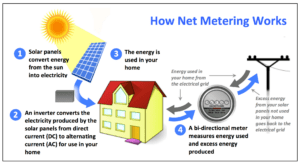Renewable generation consists of many types, including but not limited to solar, wind and geothermal. Most commonly seen in our service area is renewable generation produced by the sun. Within our cooperative, we have about 400 members that are participating in the production of renewable energy. If you are considering joining this group and want to learn more about rate schedules, rebates, the renewable energy facility registration guide or our interconnection policy, see the list of resource below or call 800.222.3107 and ask to speak to Kyle Heckman: heckmank@pemc.coop, an energy expert at Piedmont Electric.
If you’re interested in installing solar panels on your home, please review the resources below to help you make your decision.
Net metering is a utility billing process that allows members with distributed generation systems, like solar, to subtract the electrcity generated at their home from what they use. This helps to reduce their monthly power bill. If the generation is more than the member’s entire electricity consumption during the month, Piedmont Electric will purchase that generation at a wholesale power rate. Excess generation beyond consumption is credited at $0.0379 / kWh.

No. With net metering, members will not receive a separate payment from Piedmont Electric for their excess generation. Instead, any excess energy produced will offset the member’s total electricity bill during the month. Excess energy will be credited on a separate line item (Net Metering Over-Generation) in the Detail of Charges section which will offset other billing charges. If the credit exceeds all the billing charges, the credit will be carried over to the next month.
The U.S. Department of Energy has a great tool for providing cost estimates on home solar installations. Please keep in mind this is an estimate only; you will have a more accurate financial picture by working with us and a professional solar installation company.
Residential, commercial and industrial members that meet the requirements of Piedmont Electric’s Interconnection Policy are eligible to participate. The most common net metering members are residential members with solar systems that generate no greater than 25 kWh. A larger commercial or industrial member will have a different rate and set of charges. See Piedmont Electric’s Rates and Interconnection Policy for more information.
Yes and no. An appropriately sized solar system will provide most of the power a member’s home needs during the daytime, but at night and on cloudy days, it will not. Our electric grid will supply energy to our net metering members during the times their systems are not producing enough energy on their own.
Net metering has the potential to save homeowners hundreds of dollars on their utility bills every year. Unfortunately, this usually does not offset the high cost of installing their solar energy system.
Excess generation beyond consumption is credited at $0.0379/kWh.
The bi-directional meter charge is $7.50/month.
